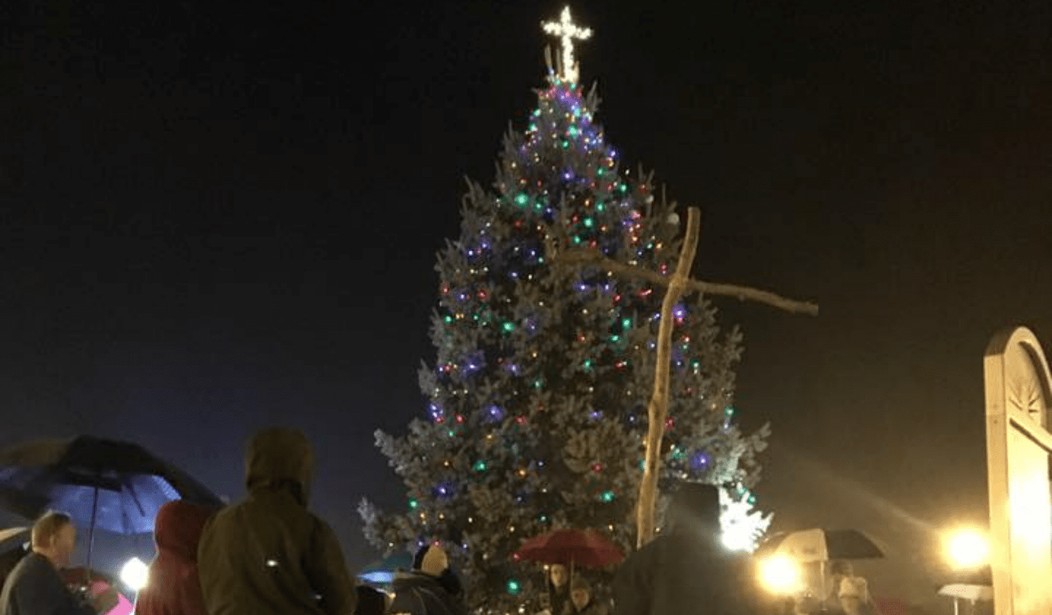The American Civil Liberties Union (ACLU) has forced a central Indiana town to remove the cross atop its Christmas tree, in order to avoid legal fees and damages. The town announced this capitulation on Monday, after the ACLU brought a lawsuit against it.
ACLU Indiana brought a lawsuit against the town of Knightstown last Thursday, arguing that the cross violated the separation of church and state, the Associated Press reported. The lawsuit alleged that Knightstown resident Joseph Tompkins “is forced to come into direct and unwelcome contact” with the tree as he drives through town. This contact has caused him “irreparable harm,” which can only be remedied by the removal of the cross and paying Tompkins’ monetary damages.
Yes, you read that right — a man claims that merely seeing the cross atop a Christmas tree has caused him “irreparable harm.” This is concrete proof that the kind of anti-speech coddling that has sadly taken over American universities can spill into the general public. Claiming to be “offended” is a trump card that can silence other people’s right to free expression. This is one of the reasons Trump won.
The suit alleged that the Latin cross “is the preeminent symbol of Christianity, representing the instrument of the crucifixion of Jesus.” Since the display is religious, the suit claimed, it has no business on town property.
On Monday, the Knightstown News and Events Facebook page announced that the town will remove the cross. “It is with regret and sadness that the Knightstown Town Council has had the cross removed from the Christmas tree on the town square and is expected to approve a resolution at the next council meeting stating they will not return the cross to the tree,” the council announced in a statement.
“We could not win the court case brought by the ACLU,” the council admitted. “We would have been required to pay the legal fees of the ACLU lawyer and monetary damage to the plaintiff, Mr. Joseph Tompkins, as set by the Court. This is our statement based on advice from our legal counsel.”
In a statement updated Tuesday, the ACLU Indiana chapter argued that Tompkins “sought only to have the religious symbol removed, and did not seek monetary damages for the suit.”
In the statement, Ken Falk, the Indiana chapter’s legal director, explicitly condemned the cross as a violation of the establishment clause. “The cross is the best known symbol of Christianity and Knightstown’s prominent display of this symbol represents an establishment of religion in violation of the First Amendment to the United States Constitution.”
Next Page: Why a cross on a Christmas tree is not an “establishment of religion.”
Here is the text of that amendment:
Congress shall make no law respecting an establishment of religion, or prohibiting the free exercise thereof; or abridging the freedom of speech, or of the press; or the right of the people peaceably to assemble, and to petition the Government for a redress of grievances.
Around America’s founding, many states (and nations, most importantly Great Britain) had established churches — the government forced people to pay religious taxes. The First Amendment explicitly declared that the federal government, the United States Congress, would not establish any religion across the country — but many states still had established religions, and this was not considered a violation of the First Amendment.
It is hard to see how the First Amendment, as intended by its authors, would prohibit the public display of a Christian symbol (or the symbol for any other religion) on public property. Especially for a local issue, the “establishment” clause should not apply, while the “free exercise” clause should protect any such display.
In the past 40 years, however, the Supreme Court decided to curb religious expression. In 1980, it struck down a Kentucky law requiring public schools to display the Ten Commandments in classrooms. The Court created a “Lemon test” from the 1971 case Lemon v. Kurtzman, stipulating that any statue or display must have a secular legislative purpose, neither advancing nor prohibiting religious freedom, and must not result in an “excessive government entanglement.”
Since “requiring the posting of the Ten Commandments in public school rooms has no secular legislative purpose,” the Court ruled it unconstitutional.
According to a 2014 Pew Research Center survey, a whopping 72 percent of Americans favor allowing Christian symbols on government property in at least some cases. While only 44 percent say explicitly religious symbols like nativity scenes should be allowed on government property even if they are not accompanied by symbols of other religions, 28 percent of adults say such symbols can be permitted so long as they are accompanied by symbols from other faiths, such as Hanukkah candles.
Only 20 percent of Americans oppose all religious displays on government property under any circumstances. These numbers show that the ACLU is not supported by the vast majority of Americans, but by only one in five who support this extreme censorship of faith symbols.
Knightstown lost this round, but Americans are waking up to the damage of such censorship. While Donald Trump may or may not be a champion of free speech, his electoral success suggests that Americans are tired of being silenced. Trump promised that if he is elected, people will be able to say “Merry Christmas!” again. Cases like this provide a way for the president-elect to put his promises into action.









Join the conversation as a VIP Member